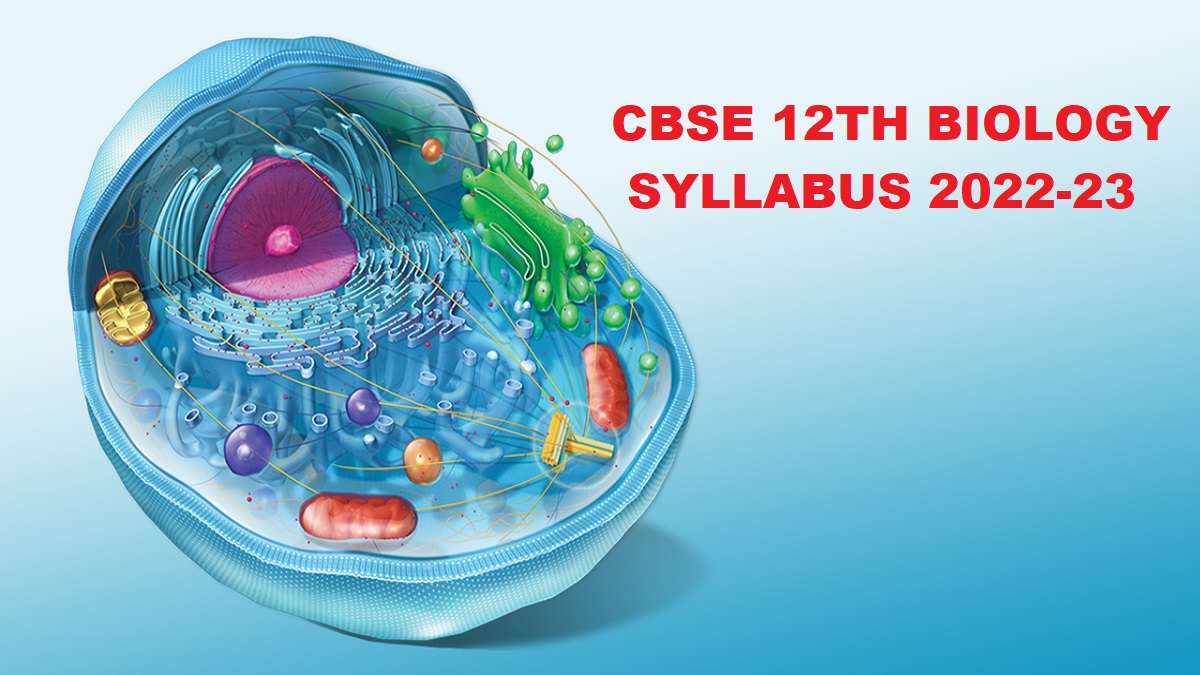Jagran Josh
Biology Syllabus Class 12 2022 – 2023: CBSE Class 12 Biology Syllabus 2022-23 can be downloaded in PDF format in the article below. You will find here the Revised Course structure, course content & Examination Scheme for both Theory and Practical exams. Check the syllabus here and note important topics to be studied.
Biology Syllabus Class 12 2022 – 2023: Check CBSE Class 12 Biology Syllabus 2022-23 in the article here. This is the revised syllabus based on which the CBSE Class 12 Biology Board Exam 2023 will be conducted. You can not only view the complete syllabus here but also download it. A certain portion of the syllabus was removed for the 2022-2023 academic session. Therefore, students must be aware of the deleted portion of the syllabus that will not be assessed in the CBSE Board Exam 2023.
CHECK: CBSE Class 12 Biology DELETED Syllabus 2022-23 to know the chapter-wise list of topics that will not be tested in the exam tomorrow.
Must Read|
CBSE Class 12 Biology Important MCQs for Board Exam 2023
CBSE Class 12 Biology Important Assertion & Reason Questions for Board Exam 2023
CBSE Class 12 Biology Important Case Study Questions for Board Exam 2023
CBSE Class 12 Biology Important Last Minute Tips 2023 To Score High in Exam
CBSE Class 12 Biology Syllabus 2022-23
Check the complete syllabus below along with the new exam scheme
CBSE Class 12 Biology Syllabus: Course Structure
|
Unit |
Title |
Marks |
|
VI |
Reproduction |
16 |
|
VII |
Genetics and Evolution |
20 |
|
VIII |
Biology and Human Welfare |
12 |
|
IX |
Biotechnology and its Applications |
12 |
|
X |
Ecology and Environment |
10 |
Related: CBSE Class 12 Biology Sample Paper for Board Exam 2023
CBSE Class 12 Biology Syllabus: Course Content
Unit-6 Reproduction
Chapter- 2: Sexual Reproduction in Flowering Plants
Flower structure; development of male and female gametophytes; pollination – types, agencies and examples; out breeding devices; pollen-pistil interaction; double fertilization; post-fertilization events – development of endosperm and embryo, development of seed and formation of fruit; special modes- apomixis, parthenocarpy, polyembryony; Significance of seed dispersal and fruit formation.
Chapter- 3: Human Reproduction
Male and female reproductive systems; microscopic anatomy of testis and ovary; gametogenesis-spermatogenesis and oogenesis; menstrual cycle; fertilisation, embryo development up to blastocyst formation, implantation; pregnancy and placenta formation (Elementary idea); parturition (elementary idea); lactation (elementary idea).
Chapter- 4: Reproductive Health
Need for reproductive health and prevention of Sexually Transmitted Diseases (STDs); birth control – need and methods, contraception and medical termination of pregnancy (MTP); amniocentesis; infertility and assisted reproductive technologies – IVF, ZIFT, GIFT (Elementary idea for general awareness).
Unit-7 Genetics and Evolution
Chapter-5: Principles of Inheritance and Variation
Heredity and variation: Mendelian inheritance; deviations from Mendelism – incomplete
dominance, co-dominance, multiple alleles and inheritance of blood groups, pleiotropy; elementary idea of polygenic inheritance; chromosome theory of inheritance; chromosomes and genes; Sex determination – in humans, birds and honey bees; linkage and crossing over; sex-linked inheritance – haemophilia, colour blindness; Mendelian disorders in humans – thalassemia; chromosomal disorders in humans; Down’s syndrome, Turner’s and Klinefelter’s syndromes.
Chapter-6: Molecular Basis of Inheritance
Search for genetic material and DNA as genetic material; Structure of DNA and RNA; DNA packaging; DNA replication; Central Dogma; transcription, genetic code, translation; gene expression and regulation – lac operon; Genome, Human and rice genome projects; DNA fingerprinting.
Chapter-7: Evolution
Origin of life; biological evolution and evidence for biological evolution (palaeontology, comparative anatomy, embryology and molecular evidence); Darwin’s contribution, modern synthetic theory of evolution; mechanism of evolution – variation (mutation and recombination) and natural selection with examples, types of natural selection; Gene flow and genetic drift; Hardy – Weinberg’s principle; adaptive radiation; human evolution.
Unit-8 Biology and Human Welfare
Chapter-8: Human Health and Diseases
Pathogens; parasites causing human diseases (malaria, dengue, chikungunya, filariasis, ascariasis, typhoid, pneumonia, common cold, amoebiasis, ring worm) and their control; Basic concepts of immunology – vaccines; cancer, HIV and AIDS; Adolescence – drug and alcohol abuse.
Chapter-10: Microbes in Human Welfare
Microbes in food processing, industrial production, sewage treatment, energy generation and microbes as bio-control agents and bio-fertilizers. Antibiotics; production and judicious use.
Unit-9 Biotechnology and its Applications
Chapter-11: Biotechnology – Principles and Processes
Genetic Engineering (Recombinant DNA Technology).
Chapter-12: Biotechnology and its Applications
Application of biotechnology in health and agriculture: Human insulin and vaccine production, stem cell technology, gene therapy; genetically modified organisms – Bt crops; transgenic animals; biosafety issues, biopiracy and patents.
Unit-10 Ecology and Environment
Chapter-13: Organisms and Populations
Population interactions – mutualism, competition, predation, parasitism; population attributes – growth, birth rate and death rate, age distribution. (Topics excluded: Organism and its Environment, Major Abiotic Factors, Responses to Abiotic Factors, Adaptations)
Chapter-14: Ecosystem
Ecosystems: Patterns, components; productivity and decomposition; energy flow; pyramids of number, biomass, energy (Topics excluded: Ecological Succession and Nutrient Cycles)
Chapter-15: Biodiversity and its Conservation
Biodiversity-Concept, patterns, importance; loss of biodiversity; biodiversity conservation; hotspots, endangered organisms, extinction, Red Data Book, Sacred Groves, biosphere reserves, national parks, wildlife, sanctuaries and Ramsar sites.
Also visit:
CBSE class 12 Biology sample paper 2022-23
NCERT Books for Class 12 Biology ALL Chapters
RELATED SYLLABUS:
All the best!
#CBSE #Class #Biology #Syllabus #Board #Exam #Important #Resources #Minute #Preparation
